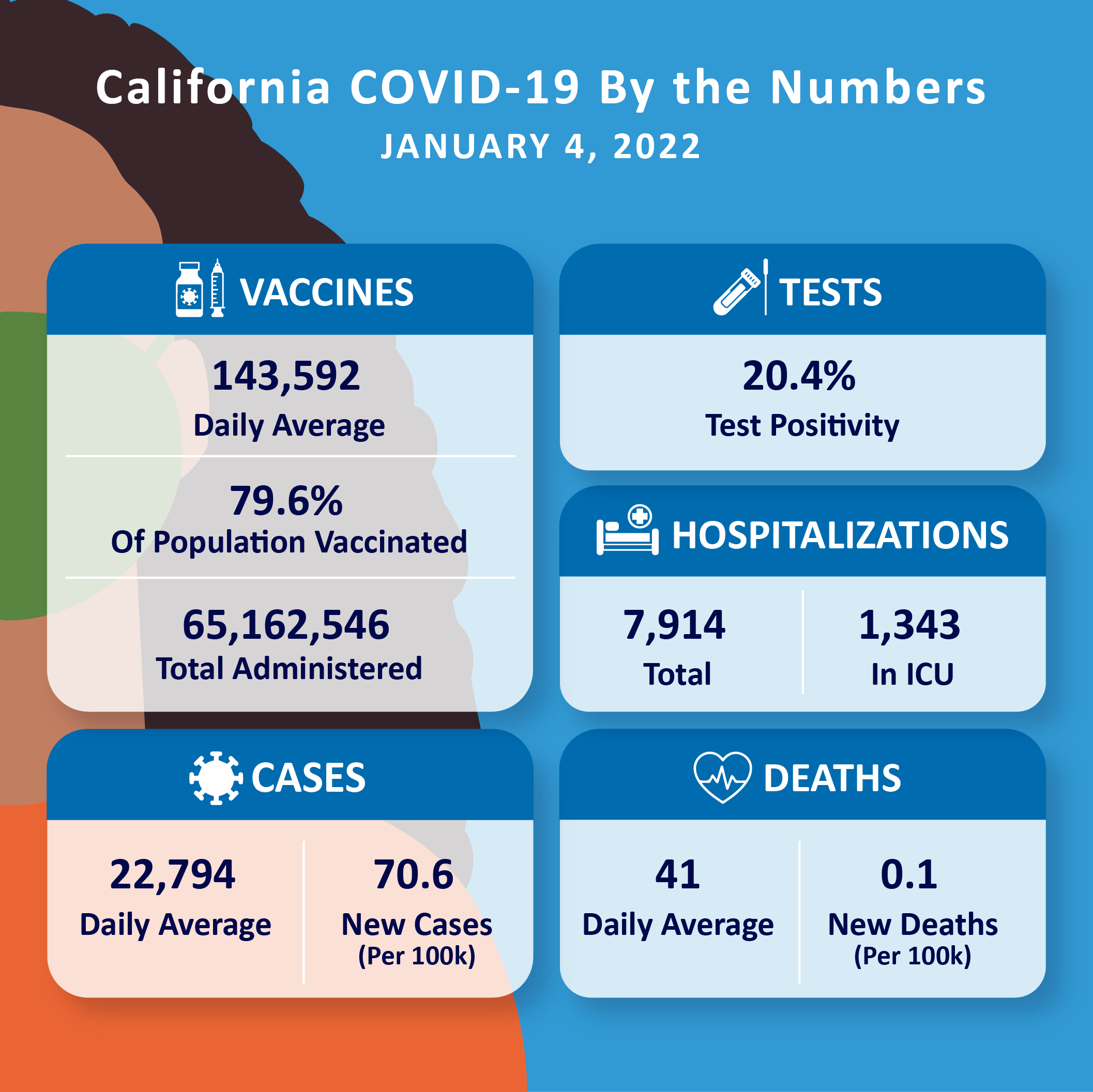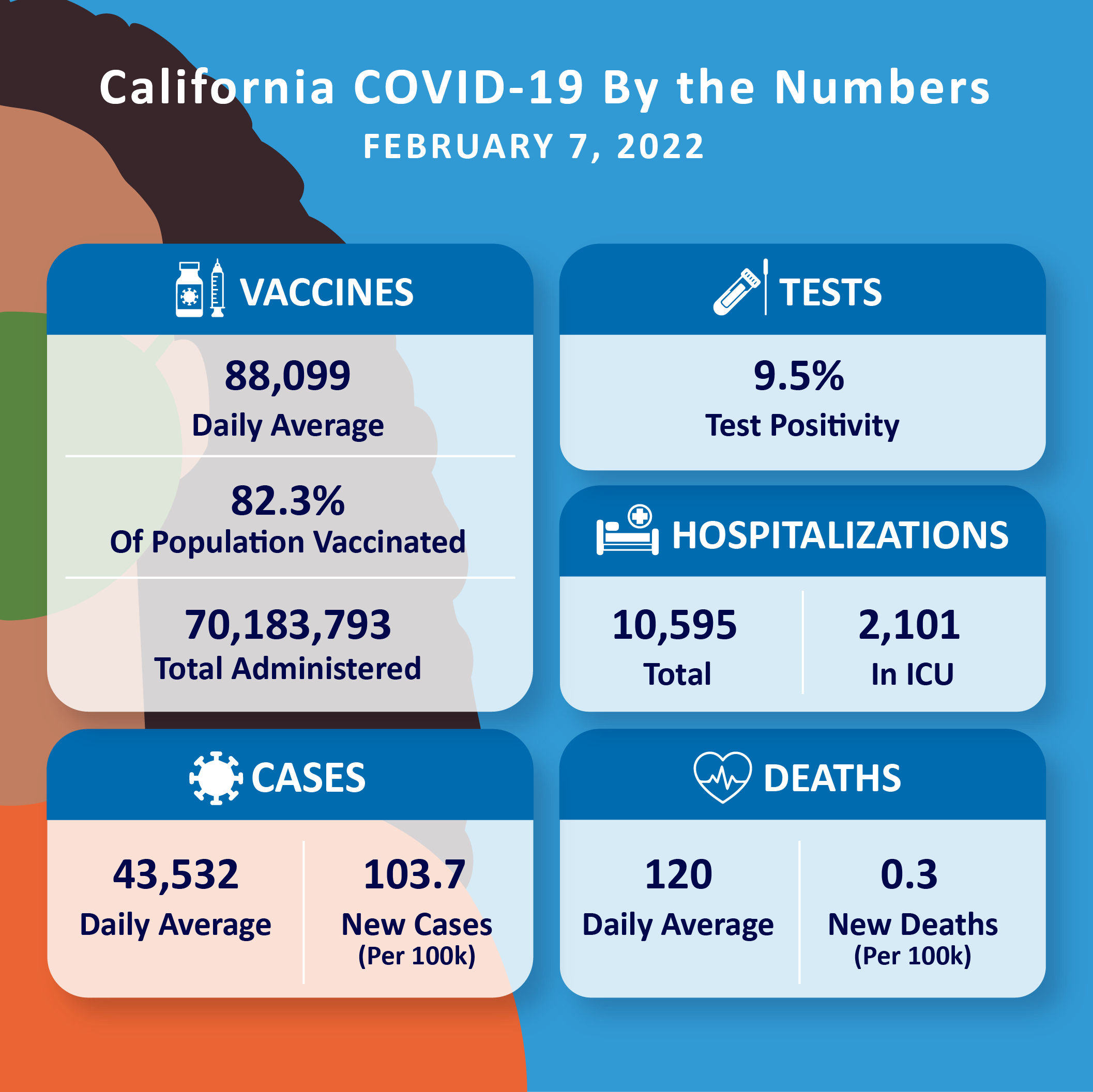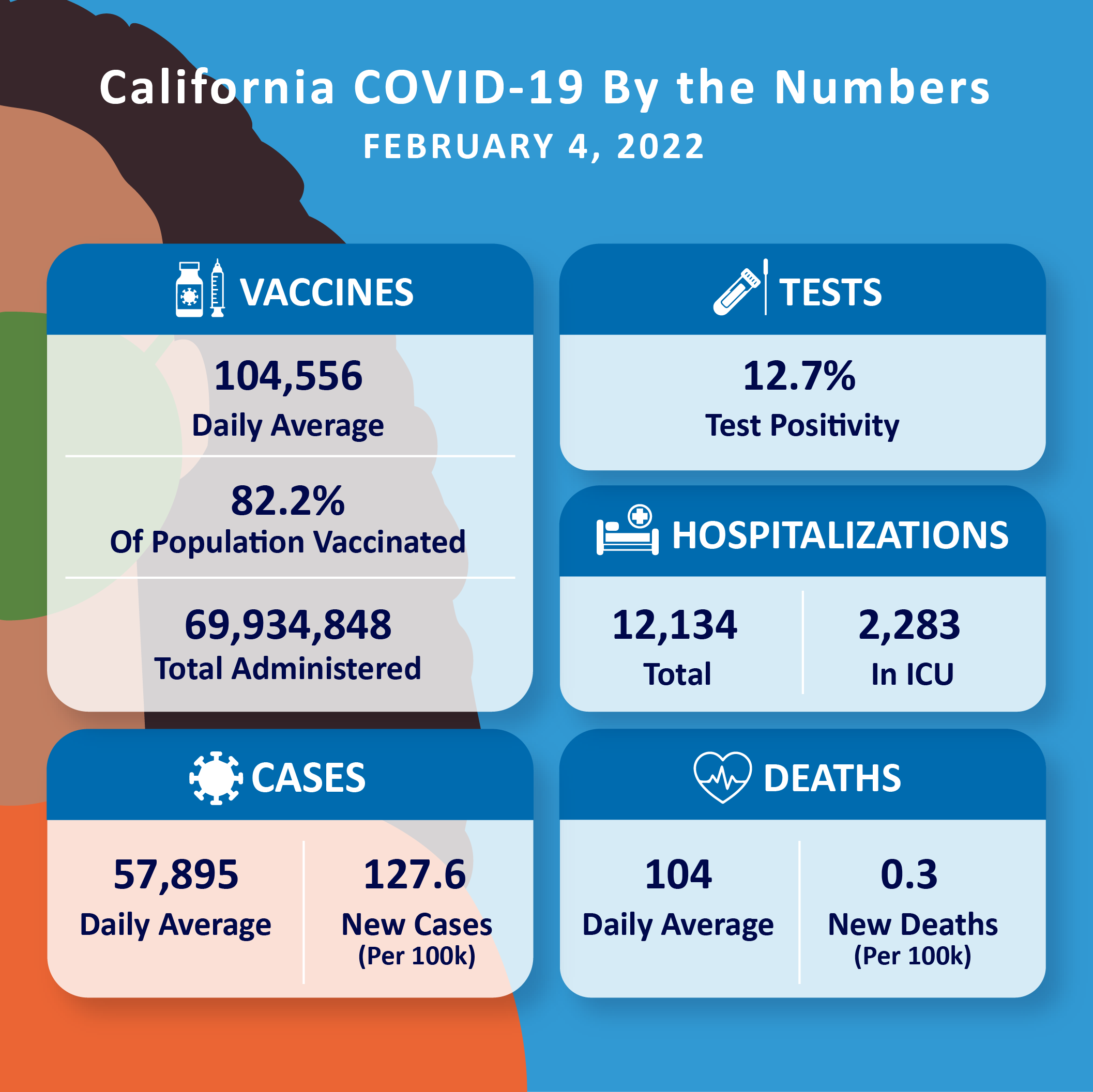Date: February 7, 2022
Number: NR22-027
Contact: CDPHpress@cdph.ca.gov
SACRAMENTO – As COVID-19 conditions continue to improve across California and the Omicron surge subsides, temporary measures the state had put in place will expire in the coming weeks.
COVID-19 cases and the rate of community transmission have steadily decreased statewide since early January, and hospitalizations are either plateauing or declining in most regions of the state. Since California's peak during the Omicron surge, the state has experienced a 65% decrease in case rates.
Additional visitation requirements that took effect on January 7 for long-term care facilities and hospitals will expire today. Definitions for indoor and outdoor mega events will return to pre-surge guidance (from 500 to 1,000 attendees for indoor events, and 5,000 to 10,000 attendees for outdoor events) after February 15. The indoor masking requirement will expire after February 15 reverting to the previous guidance which requires masking for unvaccinated individuals in all indoor public settings and required masking for all individuals regardless of vaccination status in higher risk settings like public transit and congregate living. Workplaces will continue to follow the COVID-19 prevention standards set by CalOSHA.
The state is continuing to work with education, public health and community leaders to update masking requirements at schools to adapt to changing conditions and ensure the safety of kids, teachers, and staff.
Additional adjustments to the state's policies will be shared in the coming week.
"Omicron has loosened its hold on California, vaccines for children under 5 are around the corner, and access to COVID-19 treatments is improving," said Dr. Tomás J. Aragón, CDPH Director and State Public Health Officer. "With things moving in the right direction, we are making responsible modifications to COVID-19 prevention measures, while also continuing to develop a longer-term action plan for the state."
Additional information on visitation requirements can be found here:
CDPH All Facilities Letter
CDSS Provider Information Notice
Statewide COVID-19 Data
Rates of cases, hospitalizations and deaths are highest among unvaccinated individuals and lowest among boosted individuals. This is true for all age groups. See additional data for unvaccinated and vaccinated cases, hospitalizations and deaths.

 Vaccinations
Vaccinations
- 70,183,793 total vaccines administered.
- 82.3% of the eligible population (5+) has been vaccinated with at least one dose.
- 88,099 people a day are receiving COVID-19 vaccination (average daily dose count over 7 days).
Cases
- California has 8,079,771 confirmed cases to date.
- Today's average case count is 43,532 (average daily case count over 7 days).
- Unvaccinated people are 7.5 times more likely to get COVID-19 than boosted individuals (January 10, 2022 – January 16, 2022).
Testing
- The testing positivity rate is 9.5% (average rate over 7 days).
Hospitalizations
- There are 10,595 hospitalizations statewide.
- There are 2,101 ICU patients statewide.
- Unvaccinated people are 14.9 times more likely to be hospitalized than boosted individuals (January 10, 2022 – January 16,2022).
Deaths
- There have been 80,539 COVID-19 deaths since the start of the pandemic.
COVID-19 claims the lives of 120 Californians each day (average daily death count over 7 days).
Unvaccinated people are 30.0 times more likely to die than boosted individuals (January 1, 2022 – January 9, 2022).
ADDITIONAL UPDATES
Slow the Spread: Get Vaccinated and Boosted for COVID-19
The risk for COVID-19 exposure and infection continues as a number of Californians remain unvaccinated and unboosted.
Real-world evidence continues to show that the vaccine is preventing severe illness, hospitalization, and death. With the combination of colder weather keeping people indoors, the waning of vaccine and natural immunity, the spread of the Omicron variant, and more mingling among non-household members, public health officials urge Californians to get vaccinated and boosted as soon as possible.
It is recommended that every vaccinated person 12 years or older should get a booster as long as they received their second dose of the Pfizer or Moderna vaccine at least five months ago or they received their Johnson & Johnson vaccine at least two months ago.
Vaccination appointments can be made by visiting the MyTurn website (myturn.ca.gov) or calling 1-833-422-4255. The consent of a parent or legal guardian may be needed for those under age 18 to receive a vaccination. Visit Vaccinate All 58 to learn more about the safe and effective vaccines available for all Californians 5+.
Your Actions Save Lives
Protect yourself, family, friends and your community by following these prevention measures:
Slow the spread of Omicron: The emergence of the Omicron variant emphasizes the importance of taking prevention efforts needed to protect against COVID-19, including getting a vaccine or booster. For information on Omicron and other variants, see the CDPH variant webpage. For information on genetic sequencing, see the COVID-19 data chart.
Wear your mask: The requirement for mandatory indoor masking will expire
after February 15, reverting to the
previous guidance which requires masking for unvaccinated individuals in indoor
settings and requires masking all individuals regardless of vaccination status
in higher risk settings like public transit and congregate living.
Upgrade your mask: Good fit and filtration continue to be the best way to get the most out of your mask. The best masks for preventing COVID-19 include the N95, KN95 and KF94. If you don't have access to one of these masks, wear a surgical mask or a surgical mask with a cloth mask on top. If you choose a fabric mask, opt for one with three of more cloth layers. No matter what kind of mask you wear, check the fit by avoiding gaps above the nose or on the sides.
Get vaccinated for COVID-19 and flu: It's your turn now! It's recommended for everyone over six months of age to be vaccinated for the flu. For COVID-19, Californians age 5+ are eligible to make appointments or go to a walk-in site for vaccination. You can get your flu and COVID-19 vaccines on the same day.
My Vaccine Record is an easy way to show vaccination status at venues or businesses that require proof of vaccination. Visit the Digital COVID-19 Vaccine Record website today to get your vaccine record.
Stay Home & Get Tested if Sick: If you are experiencing symptoms of COVID-19 (fever, cough, shortness of breath, fatigue, muscle or body aches), or believe you have been exposed, get tested, call your health care provider, and stay home and away from others. Free, confidential testing is available statewide.
Isolation and Quarantine: CDPH updated guidance to align with the recommended isolation and quarantine timeframes from the Centers for Disease Control and Prevention (CDC). In this time of uncertainty due to Omicron, CDPH added additional testing recommendations to exit isolation and quarantine and improved masking measures to protect the health and well-being of all Californians.
- Recommendations for K–12 Students: On January 12, CDPH updated its current contact-tracing strategy (i.e., identifying individual close contacts of someone with COVID-19) to include new guidance regarding quarantine.
Wash hands with soap and water for at least 20 seconds.
Travel tips: Delay travel (both domestic and international) until you are fully vaccinated. See the CDC's full travel guidance. If you decide to travel, a recent travel advisory recommends that all travelers arriving in California test for COVID-19 within three to five days after arrival, regardless of their vaccination status.
Avoid crowded venues or areas when cases are high. CDPH has updated requirements for attending mega events, like concerts and sporting events. Venues covered by the requirement must be in full compliance no later than January 15, 2022. Prior to attending an event, attendees will now be required to provide either proof of vaccination, a negative antigen COVID-19 test within one day of the event, or a negative PCR test within two days of the event.
Add your phone to the fight: Sign up for COVID-19 exposure notifications from CA Notify. Also, individuals who test positive for COVID-19 – including those who test at home – are able to alert others of a potential exposure more quickly and conveniently. Individuals can now initiate the notification process as soon as they are aware of their positive test result. For more information, please visit the "Notify Others" page on CA Notify.
Answer the call or text if a contact tracer from the CA COVID Team or your local health department tries to connect.
Check with your local health department about local conditions. Local health jurisdictions can implement protocols that are stricter than state guidance.
Tracking COVID-19 in California
Testing Turnaround Time
The testing turnaround time dashboard reports how long California patients are waiting for COVID-19 test results. During the week of January 23 to January 29, the average time patients waited for test results was 1.4 days. During this same time period, 71% of patients received test results in one day and 88% received them within two days.
Multisystem Inflammatory Syndrome in Children (MIS-C)